 |
 |
 |
| |
New HIV Drugs, Aging, Life Expectancy
|
| |
| |
Download the PDF here
from Jules: in today's Plenary session on the last day of IAS Alexandra Calmy from Geneva University in Switzerland delivered a good summary slide talk -attached - summering many issues where she did NOT however talk about aging & comorbidities but she did have a slide on Life Expectancy which I discuss below, and aging, the AGING CRISIS, certainly affects life expectancy, which very much needs to be discussed, I do below. Calmy did discuss new drug development. Below is a slide she presented summarizing new HIV drug development. Many are very happy with the pipeline, I am not that please - we need safe & tolerable HIV therapy and although everyone raves how many choices for ARTs we have for patients with drug resistance the choices are more limited than people think, we really only have PIs, integrate & NNRTis as the main drug in the regimen. In addition for aging older patients with comorbidities & frailty or creeping up on frailty what are the better treatments? Researcher leaders & government leaders refuse to recognize & pay adequate attention to Aging & HIV. Mark my words this will explode with much worsening death rates & frailty & disabled patients increasing in numbers - where will they house these disabled patients. 80% with HIV in the USA are already over 40-45, 50% over 50 & 25% over 60. Soon 50% will be over 60. And if you think the recommendation to start ARTs at early & higher Cd4 count will eliminate or greatly diminish the problem, it will NOT. First, many delay therapy start for many reasons. Second, HIV is the problem, it causes inflammation & immune activation which is a major cause for premature aging, its the virus !. Starting earlier does not eliminate this problem. Globally in poor countries they are debating & with the WHO replacing EFV with dolutegravir - and debating should it be first line or second line. Several years ago I attended a WHO meeting at CROI in Seattle where they wanted to make EFV 400 mg the firstline regimen & I had to argue that dolutegravir should be firstling or at least an integrase, and believe it or not I had stiff resistance, they must be kidding. Now they debate DTG access, give me a break. Clearly integrase should be available firstling everywhere. Now with raltegravir ISENTRESS once a day looking good & with the new NNRTI doravirine which is said not to have NNRTI psychiatric side effects but this is yet to be actually very well proven in a study - there are additional options globally, certainly not EFV and EFV 400mg was simply a very bad idea. Cure & PrEP are sucking all the air out of the room - there is no room for discussing Aging, we need a National Discussion on Aging. Cure is a distant hope, set aside by many but NOT all, who now think functional cure is the goal, which at this point in time has little indication there are very strong leads or good study results - for either cure or functional cure. And using ART interruptions in cure research is an abomination & insult to the patient community, the deception on this by researchers is offensive.
Calmy slide presentation attached:
This slide shows the rich HIV pipeline in clinical evaluation,
with the aim of viral suppression.
(1) There are still "first in class" compounds, marked with a star, that warrant our attention regarding their activity against multi drug resistant viruses. (2) Long acting drugs, whatever adminstration route, are representing more than 50% of this pipeline; they will be evaluated for both treatment, and prevention.
(3) antibodies targeting HIV receptor or co-receptor, such as ibalizumab or pro-140, add the pOtential for dual antibody approaches.
(CLIC) I will present a one drug in phase 1, and the phase 3 fostemsavir to illustrate the potential for further changes in prescription practices.
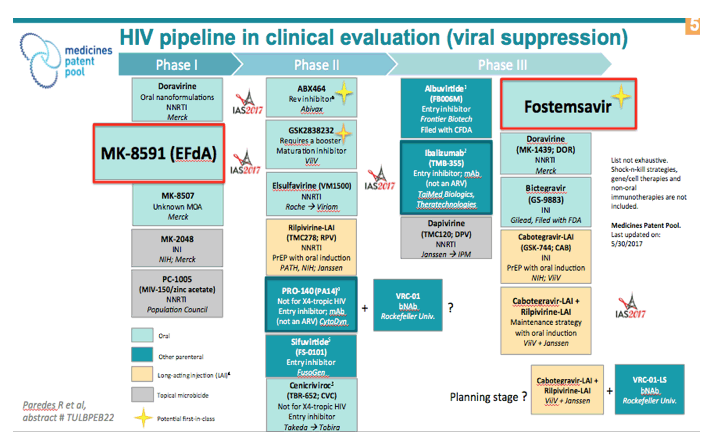
The MK-8591 is a potent nucleoside reverse transcriptase translocation inhibitor with a half-life of 150 hours in PBMCs. A once-weekly oral dose of only 10 mg was proven more effective than daily TDF and TAF, and the potential for a long-acting formulation using implants, is studied.
IAS. Phase 1b, 0.5 a 30 mg (ORAL???) - Matthew contacte mais reste sans reponse. MK supressesHIV replication for at least 7 days when administered as a single dose as low as 0.5 mg. New paradigm for both treatment and prophylaxis
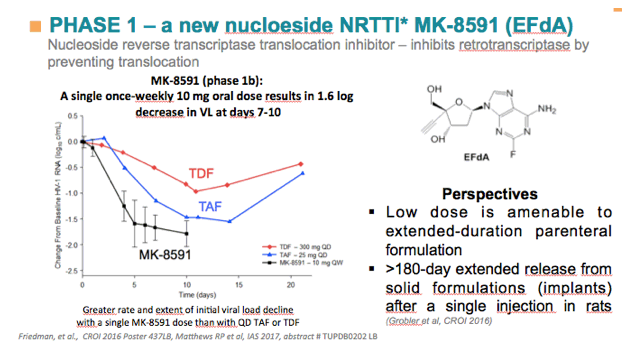
Fostemsavir is an attachment inhibitor - acting at the entry point of the virus in the cell. This first-in-class compound has now reached phase 3 trials and may provide the additional tool needed by ART multi-experienced patients.
Binds to HIV-1 env prior to co-receptor binding and fusion
In vitro activity against HIV-1 viruses (except subtype AE and Group O)
Active against CCR5-, CXCR4- and dual-tropic (R5X4) strains of HIV-1
Unique resistance profile with no in vitro cross-resistance to other classes of antiretrovirals.
Selected dose 600 mg BID
Safety and efficacy of the HIV-1 attachment inhibitor prodrug fostemsavir in antiretroviral-experienced subjects: week 48 analysis of AI438011, a Phase IIb, randomized controlled trial.
Thompson M, Lalezari JP, Kaplan R, Pinedo Y, Pena OAS, Cahn P, Stock DA, Joshi SR, Hanna GJ, Lataillade M; AI438011 study team.
Antivir Ther. 2016 Dec 6. doi: 10.3851/IMP3112. [Epub ahead of print
Fostemsavir (GSK3684934-formerly BMS-663068) is a first-in-class attachment inhibitor that binds to HIV-1 gp120, preventing initial viral attachment and entry into the host CD4+ T-cell.It is active against CCR5-, CXCR4- and dual-tropic (R5X4) strains of HIV and has an unique resistance profile with no in vitro cross-resistance to other classes of ARVs. 96 weeks results from a phase 2 study that enrolled treatment experienced individuals showed that fostemsavir virologic response rates (HIV-1 RNA <50 c/mL) were generally similar for fostemsavir and ATV/r arms at Week 96, was well tolerated, with no related AEs leading to discontinuation. Ongoing phase 3 study in heavily treatment-experienced adults with limited therapeutic options will have 24 weeks results available in the summer.
I would like to underline the interesting role of highly potent broadly neutralizing antibodies in this pipeline. Crowell et al have shown that administering broadly neutralizing antibodies to virally suppressed, early treated volunteers was associated with slightly delayed rebound of HIV after interruption of antiretroviral therapy (ART). These results are not clinically significant, so why is it worth exploring this field further?
First, It provides the basis for future studies with combination bNAbs of higher potency (2) they have the potential as immunotherapy similar to the rational of cancer immunotherapy
A new study has shown that administering broadly neutralizing antibodies to virally suppressed, early treated volunteers was associated with slightly delayed rebound of HIV after interruption of antiretroviral therapy (ART). "This is the first time that VRC01 antibody has been evaluated in early-treated people who were diagnosed during acute HIV infection," said research physician Dr. Trevor Crowell, who presented the findings. "We hypothesized that broadly neutralizing antibodies might be more likely to impact viral load in these volunteers because they have a smaller HIV reservoir than those with chronic HIV, and they show signs of less viral diversity, meaning they have a more limited resistance to VRC01.
Thirteen volunteers were randomized into an intervention group that received VRC01, a broadly neutralizing antibody that inhibits multiple strains of HIV, and five volunteers were randomized into a placebo group. Volunteers received infusions at the time of ART interruption and every three weeks after until either their viral load rebounded or they reached 24 weeks post-treatment interruption without rebound.
Viral load tended to rebound later in people that received VRC01, at a median of 26 days versus 14 days in the placebo group. Eighteen of 19 volunteers who received VRC01 rebounded, but one participant from the intervention group continues to be virally suppressed without ART at XX weeks post-treatment interruption.
"Although the slightly delayed time to viral load rebound with VRC01 seen here is not clinically significant, it taught us 2 important lessons," said Dr. Jintanat Ananworanich, Associate Director for Therapeutics Research at MHRP. "It provides the basis for future studies in early treated people with combination bNAbs of higher potency, and we can now investigate the samples from this study to identify factors that might have contributed to the delay in rebound, especially for the participant who still has not experience rebound."
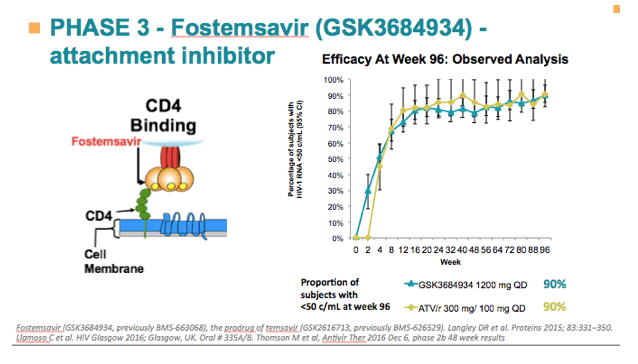
First ARVs do not cure HIV. Early ARV prescription limits the reservoir size.
Strategies to reduce the size of the reservoir include: render cells HIV-resistant, enhance the immune response or flush out the reservoir and remove the infected cells - the so-called "shock and kill" strategy.
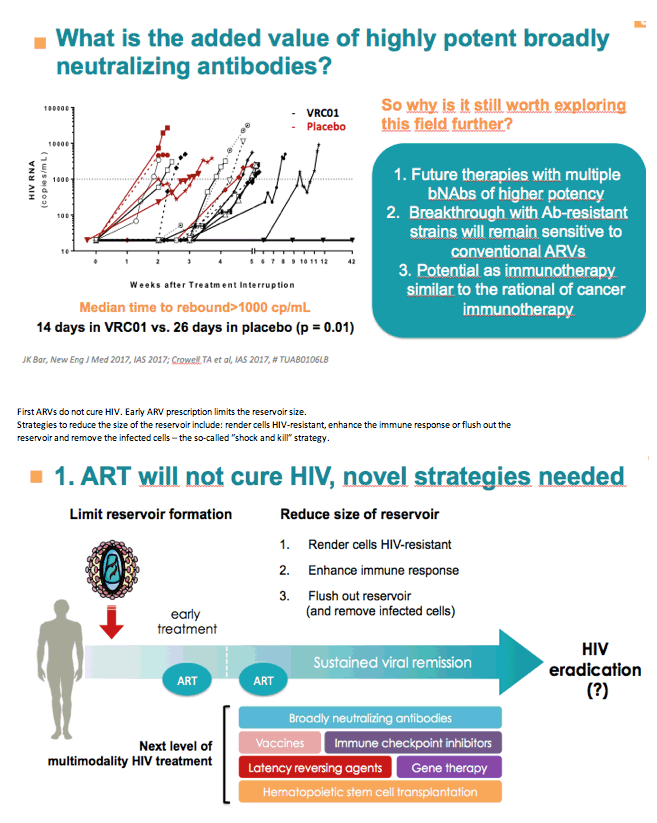
My slide / Life Expectancy - life expectancy studies cannot predict survival because they are only estimates & projections & do not include prospective comotbidities development & frailty, you just cannot build that into a study of projections & estimates. There is no doubt to me that with the aging populations now deaths will increase & quality of life is already worse & much worse for many. All the gains in HIV care & treatment are diminished because of this problem, which is dismissed & not recognized by government & research leaders globally & in the USA. PrEP & Cure have sucked all the air out of the room & there is little or no adequate support to address the many aging issues - we need better research to understand the science & find medical interventions and perhaps more important, we need special support services for the suffering aging harshly affected by the aging crisis: multiple comorbidities, polypharmacy, disability, cognitive & neurologic impairment, emotionally & physically homebound, worsened stigma, depression, housing & income problems. What will we do to house completely disabled HIV+ ??
1. morbidity and mortality from cardiovascular disease are more than 50% greater in HIV-infected individuals than in uninfected individuals. In most studies, this difference persists even after adjustment for differences in traditional risk factors such as smoking, hypertension, dyslipidemia, and diabetes mellitus
2. Life Expectancy - Among patients with HIV infection, estimated life expectancy at age 20 has increased from 36.1 additional years during 1996-1999 [1] to 53.1 during 2008-2011 [2] because of progressive improvements in antiretroviral therapy (ART) regimens and earlier diagnosis and treatment [3,4]. Despite these improvements, a significant gap remains compared with the uninfected population for whom life expectancy at 20 years in 2011 was estimated at an additional 59.5 years [5]. This gap is likely due to a corresponding increase in chronic comorbidities, for which the increasingly aging HIV-infected population is at greater risk [6,7].." from Jules: First I want to mention the Samji study from 2013 that reported a 20 year lower life expectancy for HIV+ who started HAART with CD4 less than 350 study. Overall LE was 71 years, 67 years if started ART with <350 CD4 and 88 years if started ART with over 350 CD4 and this 88 year lifespan may be hard to believe. Although many life expectancy studies show perhaps several years reduction in life expectancy as this study referenced above, none of these studies are truly able to evaluate life expectancy because they are merely estimates based on projections and NEVER include estimates of comorbidities which is impossible to predict anyway. In particular frailty & disability are also cognitive impairment are pretty much beyond predicting estimates. In addition, quality of life cannot is never evaluated & is very difficult to evaluate and in HIV+ with multiple comorbidities & polypharmacy and even more in aging HIV+ quality of life is very often very burdensome. HERE is an interesting study that looks at life expectancy & quality of life and finds a BIG difference in life expectancy & quality of life between HIV+ & HIV-uninfected. The caveat here is the study is in British Columbia where IDU among HIV+ is high but the study does reflect how comorbidities affects lifespan & quality of life. Comorbidities & Life Expectancy: the affect of comorbidities on Life Expectancy - (03/15/17). Even in the Swiss Cohort reported at IAS 2016 life expectancy study the best estimates are a lifespan of 74 years in a 74% male population which still falls apparently 10 years short in HIV-uninfected and 5 years short for those with a higher education http://www.natap.org/2016/IAC/IAC_93.htm - In a Spanish cohort reported at Glasgow 2016 excess mortality rates in HIV+ were MUCH higher compared to the general population and for HIV+ over 50 the excess mortality rate was apparently 5 fold higher compared to general population http://www.natap.org/2016/GLASGOW/GLASGOW_45.htm - In a Kaiser study at CROI 2016, which also was an estimate based on data from 1996-2011, the life expectancy gap found was 12 years shorter for HIV+ compared with HIV-uninfected (73 years of age lifespan in HIV+ vs 85 in HIV-uninfected) and there still was an 8.5 year gap for those that initiated ART at CD4 over 500 with a life expectancy of 74 years, but Blacks (4 year gap among HIV+ for Blacks vs Whites) & IDUs and women (2 year gap for HIV+ women vs men) had lower life expectancies. In this study however if an HIV+ person initiated ART at over 500 CD4 the life expectancy gap was 7.9 years and for those with had NO history of HCV/HBV, smoking, no alcohol/drug abuse and initiated ART at over 500 CD4 life expectancy gap fell to 5.7 years.
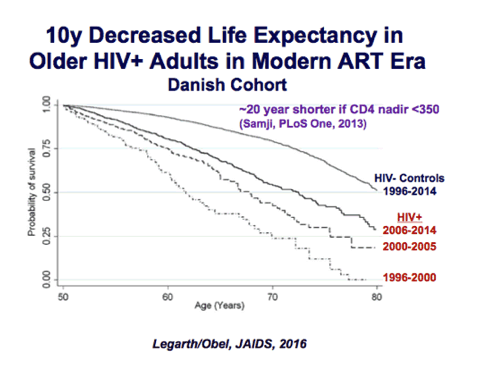
|
| |
|
 |
 |
|
|